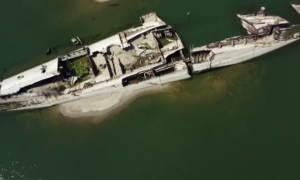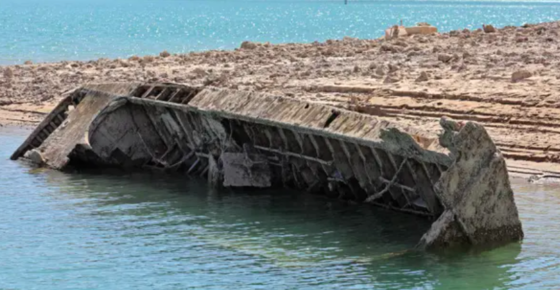
Drought exposes World War II German warships in drying Danube

Weeks of severe drought across Europe have seen water levels in rivers and lakes drop to some of the lowest levels on record, with two-thirds of the continent now in a state of alert or warning.
Thanks to low water levels, dozens of German warships, which were sunk during World War II, have resurfaced in the Danube near Serbia’s port town of Prahovo.
At least 20 vessels have been uncovered strewn across the riverbed in the ‘sunken graveyard’ — many still laden with tonnes of ammunition and explosives. They are now proving a danger to shipping and fishers in the area, and have narrowed the navigable section on the stretch near Prahovo from 180 metres to 100 metres.
Reuters reports that some of the ships still boast turrets, command bridges, broken masts and twisted hulls, while others lie mostly submerged under sand banks. The vessels were part of the Nazi Black Sea fleet, which travelled through the Danube while retreating from Soviet forces at the end of the war.
In March, the Serbian government invited a tender for the salvage of the vessels, including the removal of ammunition and explosives. The cost of the operation was reportedly estimated at €29m.

A warship from the Nazi Black Sea fleet in the Danube
“The German flotilla has left behind a big ecological disaster that threatens us, people of Prahovo,” Velimir Trajilovic, 74, a resident of the Serbian port city, told Reuters.
Water levels in the Danube reached one of their lowest points in almost a century this year, according to the Associated Press. Water levels recently fell 1.5m in three weeks, at a stretch of river near Budapest.
Preliminary data indicates this is the continent’s worst drought in 500 years, and experts are warning that drier winters and scorching summers will become the ‘new normal’ as a result of climate change.
There have been numerous other discoveries this summer related to the persistent drought across Europe and North America.

A 1944 landing craft in Lake Mead
In Spain, archaeologists have been thrilled by the emergence of the Dolmen of Guadalperal, a prehistoric stone circle popularly called the “Spanish Stonehenge”, which is usually submerged by the waters of a dam.
And in the US, low water levels in Lake Mead, the nation’s largest reservoir, have led authorities to discover numerous human skeletons since early May. Boats, including a sunken World War II-era landing craft, have also been uncovered.
Meanwhile, dinosaur tracks from around 113 million years ago have been revealed at Dinosaur Valley State Park in Texas due to severe drought conditions that dried up a river, the park confirmed in a statement this week.
